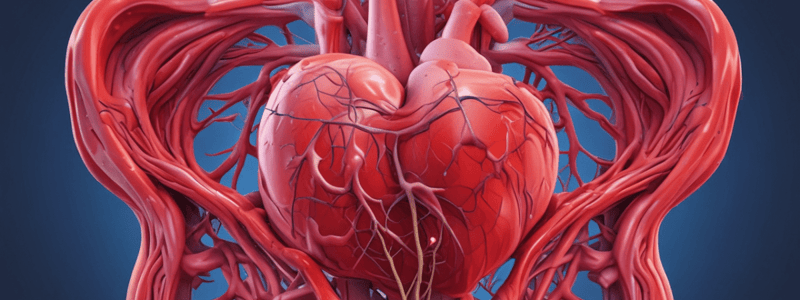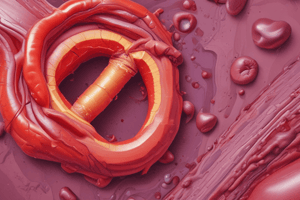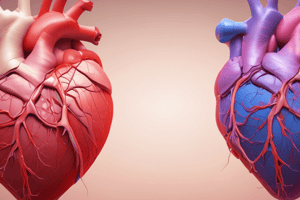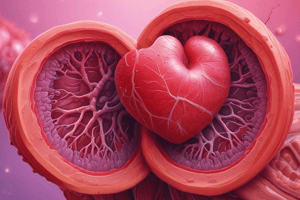Podcast
Questions and Answers
What is the main problem associated with Coronary Artery Disease?
What is the main problem associated with Coronary Artery Disease?
- Temporary cardiac ischemia
- Angina pectoris
- Myocardial infarction
- Damage to heart muscle due to insufficient oxygen (correct)
Which condition has atheromas in the walls of large arteries?
Which condition has atheromas in the walls of large arteries?
- Myocardial infarction
- Arteriosclerosis
- Atherosclerosis (correct)
- Angina pectoris
What leads to diffuse ischemia and necrosis of tissues like kidney, brain, or heart?
What leads to diffuse ischemia and necrosis of tissues like kidney, brain, or heart?
- Obstruction in arterioles
- Loss of elasticity in small arteries (correct)
- Narrowing of the lumen
- Thickening and hardening of artery walls
Which type of artery change is described as involving thickening and hardening of walls, leading to narrowing of the lumen?
Which type of artery change is described as involving thickening and hardening of walls, leading to narrowing of the lumen?
Where do atheromas typically form in the body due to turbulent blood flow at bifurcation points?
Where do atheromas typically form in the body due to turbulent blood flow at bifurcation points?
Which type of cholesterol is considered 'good' and 'bad'?
Which type of cholesterol is considered 'good' and 'bad'?
What is a major risk factor for atherosclerosis mentioned in the text?
What is a major risk factor for atherosclerosis mentioned in the text?
What is the typical treatment for angina pectoris as per the text?
What is the typical treatment for angina pectoris as per the text?
What is the most widely used tool in diagnosing myocardial infarction according to the text?
What is the most widely used tool in diagnosing myocardial infarction according to the text?
Which enzyme released from necrotic tissue is considered most specific for myocardial tissue damage?
Which enzyme released from necrotic tissue is considered most specific for myocardial tissue damage?
Which type of cardiac arrhythmia is characterized by a rapid and irregular heart rate of over 350 BPM?
Which type of cardiac arrhythmia is characterized by a rapid and irregular heart rate of over 350 BPM?
What is the mechanism behind the reduced cardiac output in ventricular tachycardia?
What is the mechanism behind the reduced cardiac output in ventricular tachycardia?
Which type of heart block is characterized by a complete lack of transmission of impulses from the atria to the ventricles?
Which type of heart block is characterized by a complete lack of transmission of impulses from the atria to the ventricles?
What is the primary purpose of using defibrillators and cardioversion devices in the treatment of cardiac dysrhythmias?
What is the primary purpose of using defibrillators and cardioversion devices in the treatment of cardiac dysrhythmias?
What is the primary cause of cardiac arrest or asystole (standstill) according to the passage?
What is the primary cause of cardiac arrest or asystole (standstill) according to the passage?
Which of the following is the primary cause of sudden death in patients with myocardial infarction (MI)?
Which of the following is the primary cause of sudden death in patients with myocardial infarction (MI)?
What is the primary mechanism by which cocaine use can contribute to dysrhythmias in patients with myocardial infarction?
What is the primary mechanism by which cocaine use can contribute to dysrhythmias in patients with myocardial infarction?
Which of the following statements about premature atrial contractions (PACs) is correct?
Which of the following statements about premature atrial contractions (PACs) is correct?
What is the primary factor contributing to the increased prevalence of paroxysmal atrial fibrillation?
What is the primary factor contributing to the increased prevalence of paroxysmal atrial fibrillation?
Which of the following statements about sinus node abnormalities is correct?
Which of the following statements about sinus node abnormalities is correct?
Flashcards are hidden until you start studying




